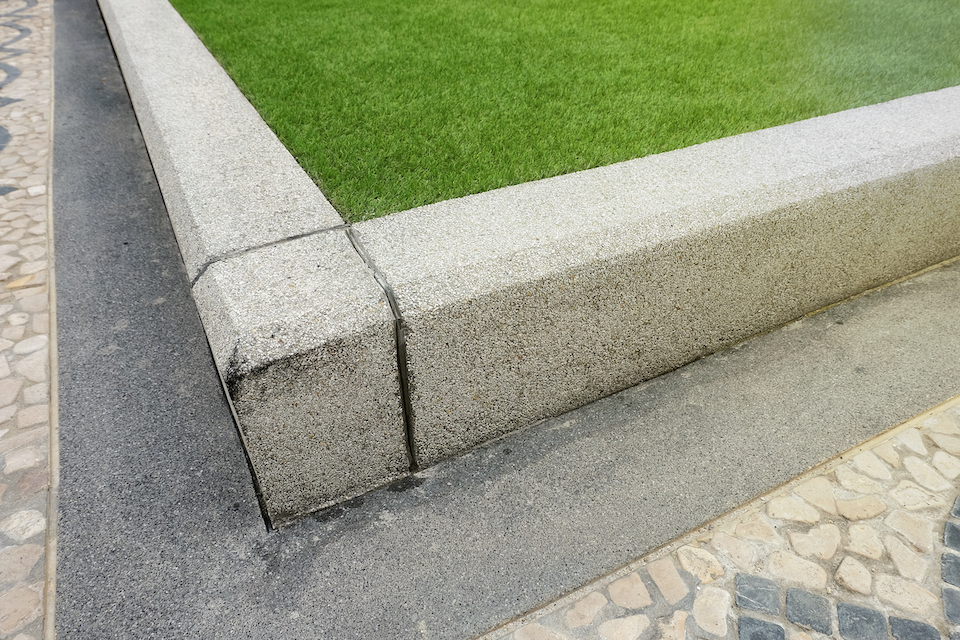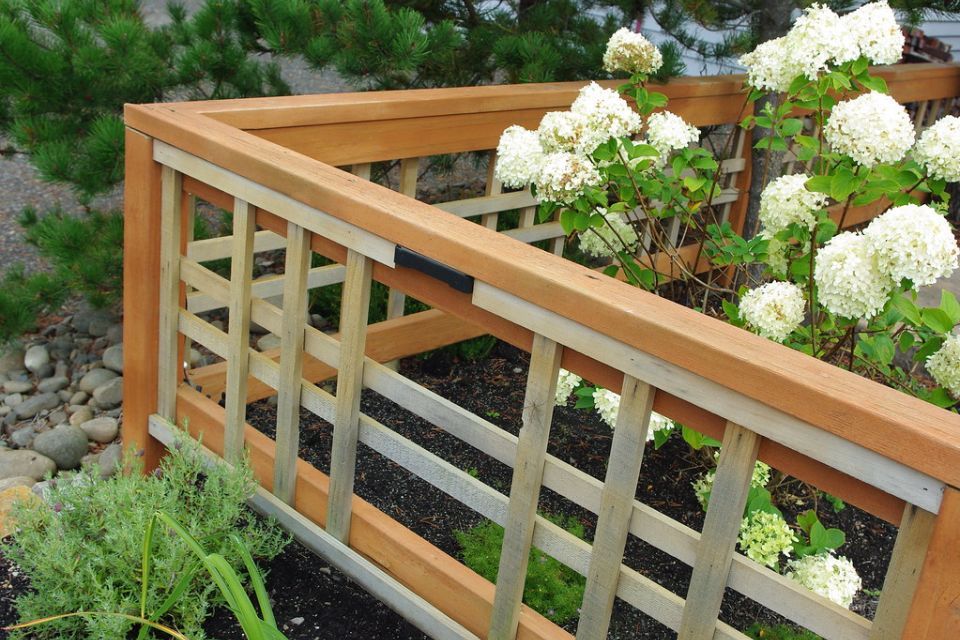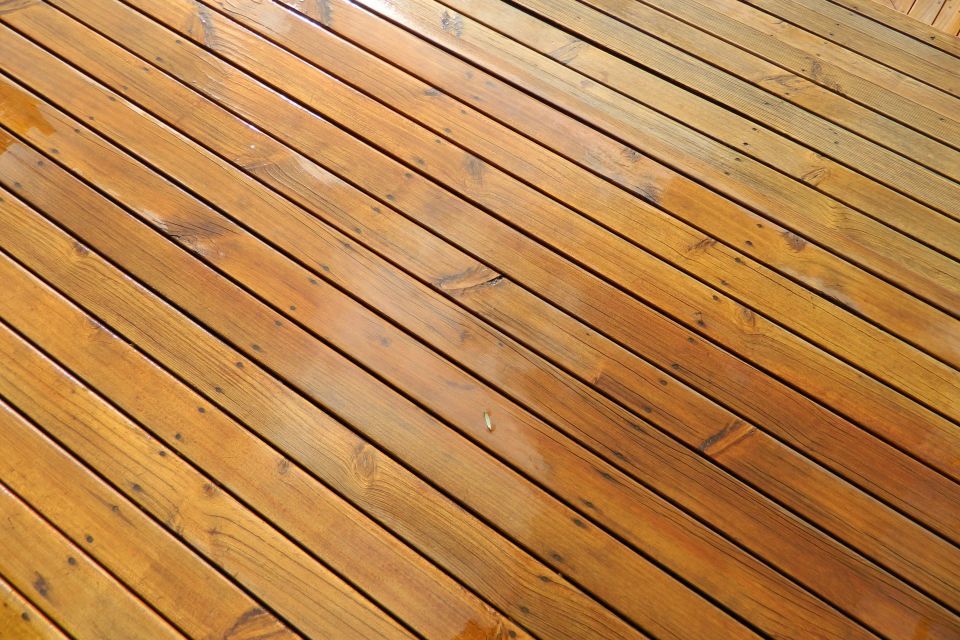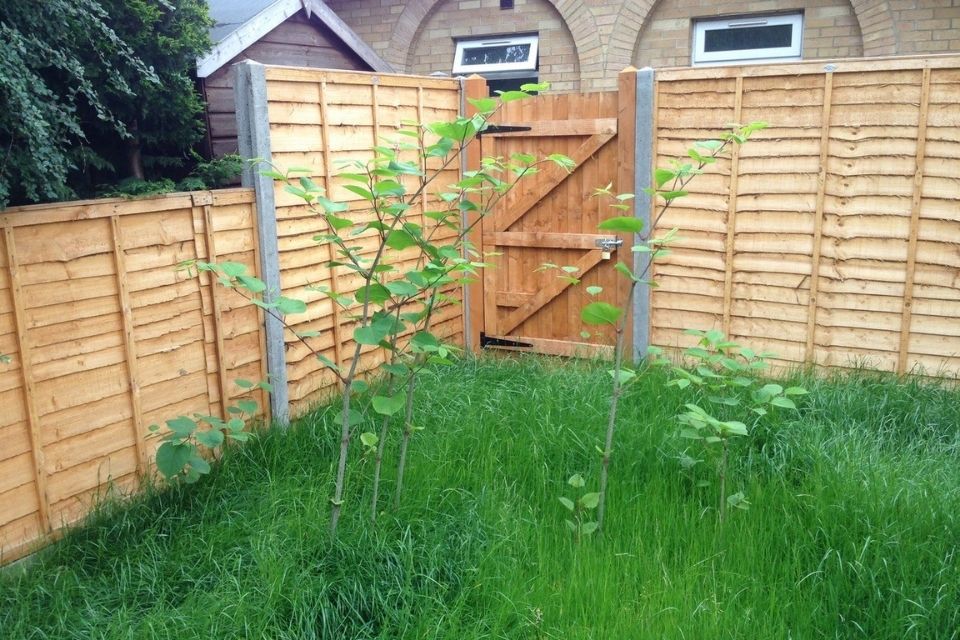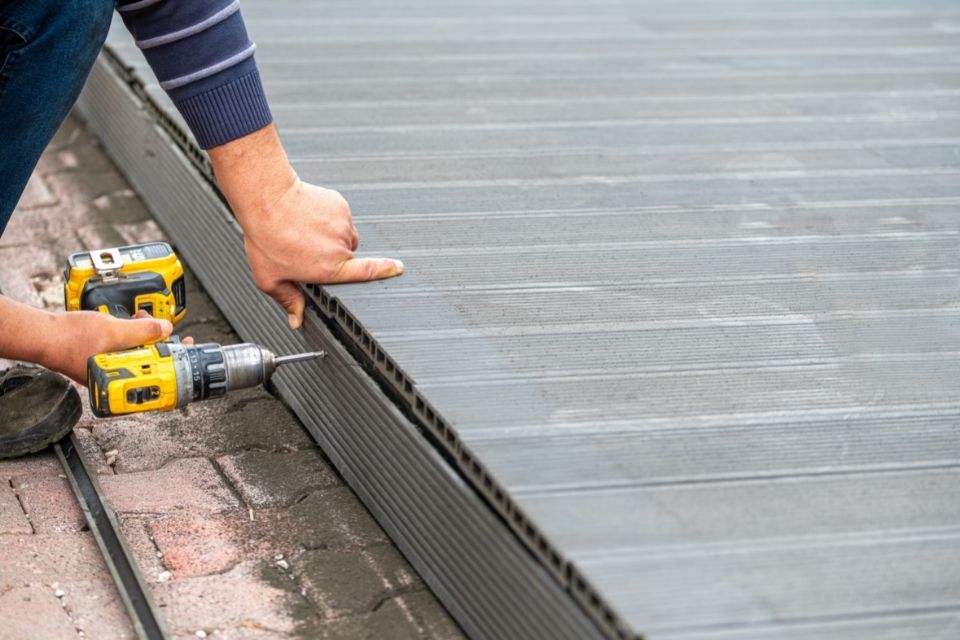How Much Does Concrete Edging Cost?
This guide will look at concrete garden edging costs, including the supply and labour costs. It will also cover how long the installation times are for different concrete edging stones.
Additional costs and the price and process of removing concrete edging will also be explained.
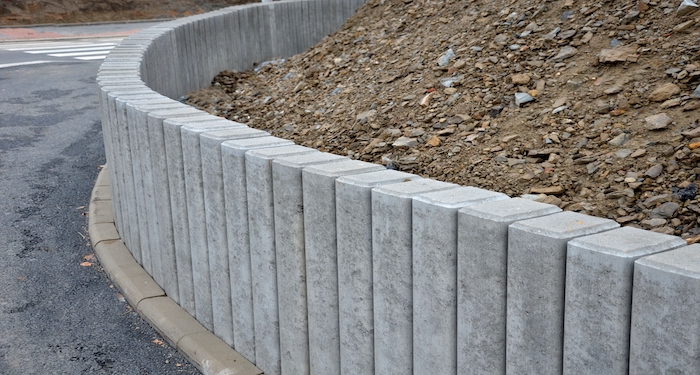
There are different types of concrete edging, such as round edge or bull-nosed edging, flat top, half batter and also some decorative concrete garden edging.
Flat top concrete edging costs around £3.50-£4.50 per linear metre. These can sit flush to your lawn to allow for easier mowing, or they can be used upright to form a low boundary.
Roundtop concrete edging is a bit pricier at between £7.00-£9.00. This type of concrete edging is more likely to be used as an upright boundary for a path or to separate a grassed area or flower bed.
Half batter concrete edging has a slanting edge, and the average cost for these is around £8-£13. These edging pieces are mostly used for kerbing and lining the sides of a driveway.
Decorative concrete lawn edging comes in various styles, such as scalloped edge, rope top and embossed designs. The average cost is approximately £7.50-£20 per linear metre. They are typically used to mark out a path or flower bed boundaries.
- How Much Does Concrete Edging Cost?
- What are the Supply Costs for Concrete Edging?
- What are the Additional Costs of a Concrete Edging Installation?
- Tradesmen Costs for Laying Concrete Edging
- How Long Does It Take to Install Concrete Edging?
- Types of Concrete Edging
- How Much Does It Cost to Remove Concrete Edging?
- FAQs
- Sources:
What are the Supply Costs for Concrete Edging?
If you want to install concrete edging stones in your garden as a DIY project, you will need to know how much it will cost you to purchase them.
The supply cost of concrete edging is purely the price of the edging stones themselves. It does not include installation or labour charges.
First, you will need to measure the distance you want to cover. It may be on both sides of a driveway, a path, or to separate, distinct parts of your garden.
An accurate measurement is important to budget properly for your project. Also, remember to allow extra for breakages and cuts.
A standard flat top concrete driveway edging will cost between £3.50-£5.50 per linear metre. These are plain concrete rectangles that can be sunk into the lawn to create a neat edge.
Roundtop concrete garden edging has softer lines, and the average cost is between £7.00-£9.00 per linear metre. This concrete lawn edging forms a barrier to prevent grass from invading flower beds and creates a clear boundary line.
Half batter concrete kerb edging features a slanted top and is effective as driveway edging. The price per linear metre is between £8.00-£13.00 on average. They can also be used as concrete path edging.
Concrete edging prices for more decorative pieces will be approximately £7.50-£20.00, depending on the design. There are embossed styles and scalloped edging, wave or rope top and many others. They make good concrete path edging or flower bed boundaries.
What are the Additional Costs of a Concrete Edging Installation?
As well as the concrete edging cost, you will need to budget for the additional costs. There are materials and equipment that are needed to install concrete edging in your garden or on your driveway or path.
Type 1 Sub-base
Type 1 consists mostly of crushed stone and provides a stable base for your concrete edging. It can level out the uneven ground and prevent the concrete edging from sinking lower into the ground.
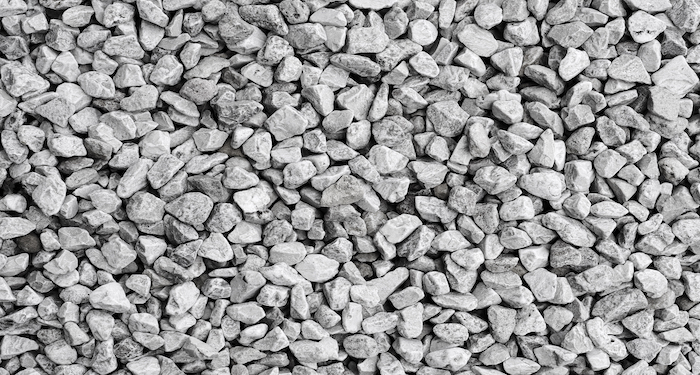
A typical bulk bag of 800kg will cover around 50 linear metres to a depth of 50mm and costs on average £50-£60. Smaller 25kg bags will cost £4.00-£6.00 and cover approximately 2 linear metres to a depth of 50mm.
Ballast
Ballast is a mixture of sharp sand and stones or gravel. It forms a bed for the concrete edging stones to sit in, providing stability and a firm foundation. A bulk bag of ballast will cover around 90 linear metres at a depth of 50mm.
The price of ballast is approximately £50-£65 for a bulk bag. 25kg bags that cover approximately 2 linear metres to 50mm cost around £2.50-£3.00.
Cement
Cement is mixed with the ballast to create concrete which the concrete edging will sit in. Without this mixture, the concrete edging can move or be knocked out of place by vehicles or gardening equipment. A 25kg bag of cement will cost around £5-£6.
Cement Mixer Hire
In order to mix the ballast and cement, you will need a cement mixer. Mixing by hand is difficult and time-consuming. A better mix is achieved with a cement mixer.
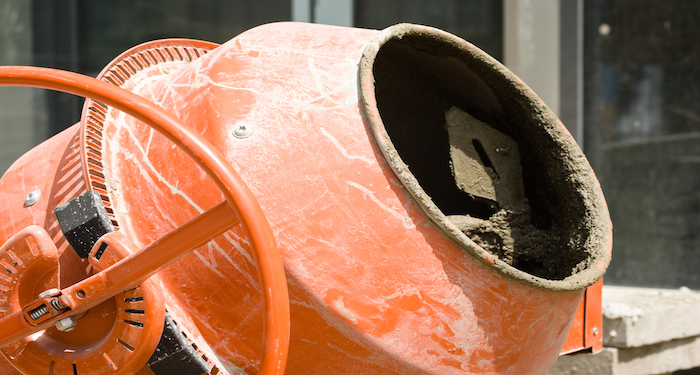
If you don’t own one, you can hire them for approximately £14-£20 per day. Electric, petrol or diesel cement mixers are available for hire throughout the UK.
Skip Hire
In order to lay your concrete lawn edging, you will need to excavate soil from your garden. Of course, how much you remove will depend on the amount of edging that you are installing, but you will need to dispose of this soil somehow.
The most convenient way is to hire a skip. A 2–4 yard mini-skip will cost around £100-£120 to hire, while a larger 6–8 yard skip can cost £250-£275 on average.
Tradesmen Costs for Laying Concrete Edging
For those who either don’t want to install concrete edging as a DIY project or those who can’t, it will be necessary to hire a tradesperson to do it for you.
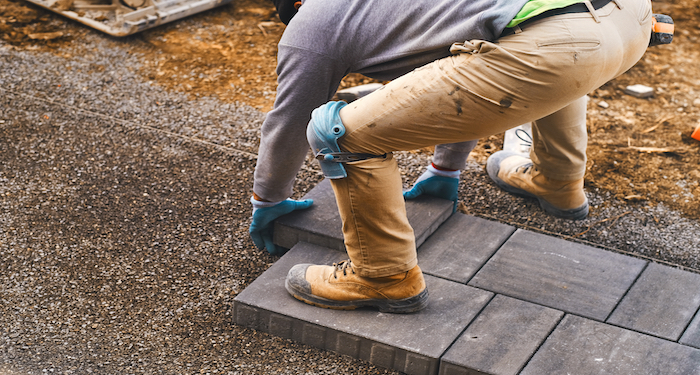
You could hire a landscape gardener or a general handyman to install your concrete edging, depending on the type and size of the project.
Hourly Rate
The average cost for a landscape gardener is around £25-£30 per hour. A general handyman will charge approximately £20-£30 per hour, depending on where in the country you live. This is for labour costs only and does not include any materials.
If the concrete edging is part of a re-design of your garden, then a landscape gardener is probably a good choice. If the project is to fit concrete kerb edging on your off-street parking, then a handyman is probably a more suitable choice.
Daily Rate
A landscape gardener will earn, on average, £110-£180 per day, depending on the area. A general handyman will earn £175-£200 per day.
Bigger jobs will take longer and may require a tradesperson to have additional labour to help mix concrete, for example. Additional labour can cost an extra £80-£100 per day.
How Long Does It Take to Install Concrete Edging?
If you are paying someone to install concrete edging in your garden, how long it will take is a reasonable question to ask. The duration will affect how much it costs if you pay by the hour or day rather than a fixed price.
The timeframes for this work will be determined by the size of the project, i.e., how large an installation you are planning if you are lining both sides of a driveway, which will take more time than edging a small garden path for instance.
Installing 50 linear metres of flat top concrete driveway edging may take up to four days. There is a lot of preparation that needs to be done, and the concrete bed needs time to cure too.
A run of 20 linear metres of round top concrete to separate a lawn from flower beds will take one and a half to two days from start to finish. Retroactively installing concrete edging between grass and flower beds requires a lot of preparatory work and digging out.
Fitting 30 linear metres of concrete kerb edging with half batter concrete units will take two days. Ensuring that everything is aligned and level is important for kerb installation.
Decorative concrete path edging is at the higher end of the budget for concrete edging prices. However, it is typically used in small runs around a garden, sectioning off lawned areas, flower beds or a pond. A 10 linear metre installation would take 6-8 hours.
Other factors can affect the installation of concrete driveway edging or decorative concrete edging in your garden. If the weather is too wet, it will not be possible to effectively set the edging in the concrete bed.
The same is true if it is very cold. If the temperature drops below freezing, the concrete can be permanently damaged.
The table below indicates the average installation times for various concrete edging projects in your garden.
| Type | Size of Project | Timframe |
|---|---|---|
| Flat Top | 50 linear metres | 4 days |
| Round Top | 20 linear metres | 1.5 days |
| Half Batter | 30 linear metres | 2 days |
| Decorative | 10 linear metres | 6-8 hours |
Types of Concrete Edging
Concrete edging is used to separate garden areas, define spaces, protect flower beds and give a neat, tidy look to your garden and property.
The type of concrete edging that you use will depend on your needs, budget and the size of the area to be covered. This section will look at some of the different types of concrete edging available and their pros and cons.
Flat Top Concrete Edging
Flat top concrete edging is made from pressed concrete and can be used in a variety of landscaping projects. It can be installed flush to the ground as a border to lawns allowing grass to be cut without edge trimming.
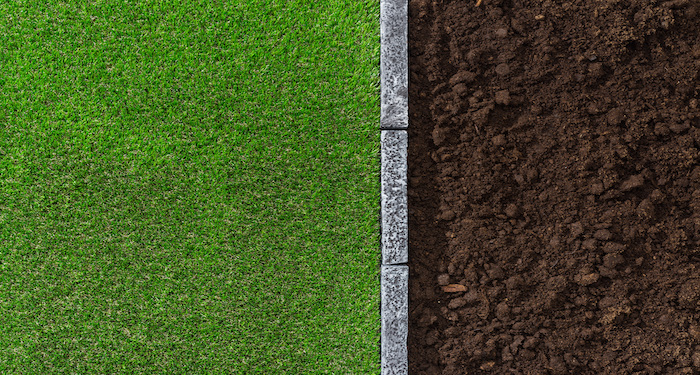
Alternatively, flat top concrete edging can be used as a raised border marker or driveway boundary.
Flat top concrete edging costs range from approximately £3.50-£5.50 per linear metre to supply. These costs may vary according to where in the UK you live and on different manufacturers and suppliers.
It is the least expensive of the concrete edging types covered in this guide.
The labour costs to install 50 linear metres of flat top concrete edging will be approximately £1,000-£1,100. This is four days at an average daily rate of £250-£275.
Timeframes may vary according to the size of the project, weather conditions and availability of materials.
Pros
- Versatile
- Inexpensive
- Durable and practical
Cons
- Industrial looking
Round Top Concrete Edging
Roundtop or bull-nosed concrete edging is very durable, suitable for holding back soil and stonework such as gravel or pebbles.
Its smoother lines make it less industrial looking than its flat top alternative, and it can be used for a multitude of gardening projects. This concrete edging looks good in most gardens as a zoning boundary or path edging.
Roundtop concrete edging has many practical applications in the garden. It can be used for marking a footpath. It can separate grassed areas from the driveway or surround a garden pond.
Its smooth lines look good in any type of garden and will not look out of place in a traditional or modern property.
The cost of concrete edging with a rounded top or bull-nosed edge is approximately £7.00-£9.00 per linear metre. Different colours such as buff or red may cost more than a standard grey variety.
To install 20 linear metres, the labour cost for concrete edging with a rounded or bullnose top will be £375-£415.
Pros
- Multiple uses
- Reasonably priced
- Softer lines than flat top
Cons
- Not the most attractive edging
Half Batter Concrete Edging
Half batter concrete edging has a slanted edge and makes an effective kerbing solution. The pieces are made using a hydraulic pressing process, making the edging very hardwearing and durable.
This concrete edging is used to best effect as a driveway edging and has non-slip properties.
The sleek look of half batter concrete edging is modern and professional. It creates a sharp and efficient boundary marker for driveways, hard standings or other landscaping features in your garden.
This concrete edging can be partnered with many different complementary or contrasting materials to enhance your garden, driveway or path.
Concrete edging prices for half batter average from £8.00-£13.00 per linear metre. However, there may be regional and manufacturer variations in price.
Labour costs for installing 30 linear metres of half batter concrete edging will cost around £500-£550, with some places in the UK, such as London, being more expensive.
As with any outside project, the weather can disrupt timeframes, and so the labour costs may increase if work is delayed.
Pros
- Effective kerb edging
- Hardwearing
- Practical
Cons
- Limited landscaping uses
Decorative Concrete Edging
Concrete edging with a decorative flair adds an interesting feature to a traditional garden or pathway. Varieties such as rope edging, scalloped edging and embossed designs are available according to your taste.
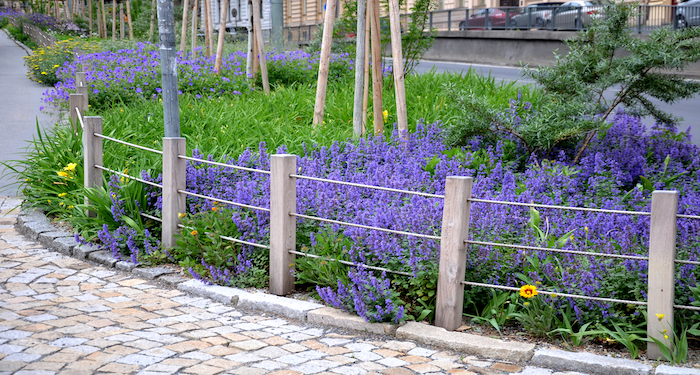
This type of concrete edging is more suited to period properties or more traditional homes. It can be used to line pathways or to define specific areas.
Decorative concrete edging is also used to protect flower beds by preventing grass from encroaching on borders.
The concrete edging cost for this decorative variety is between £7.50-£20.00, depending on the design and style.
There are several to choose from, such as rope top, scalloped edge, wave edge or even embossed Tudor roses.
To install 10 linear metres of decorative concrete edging will cost approximately £120-£240 in labour charges. These rustic and vintage styled edgings compliment many period and traditional homes.
Pros
- Selection of designs
- Multiple uses
- Keeps grass from invading flower beds
Cons
- Relatively expensive
- Dated
How Much Does It Cost to Remove Concrete Edging?
Despite its reputation as a durable material, concrete can degrade for all sorts of reasons, and concrete edging is no different.
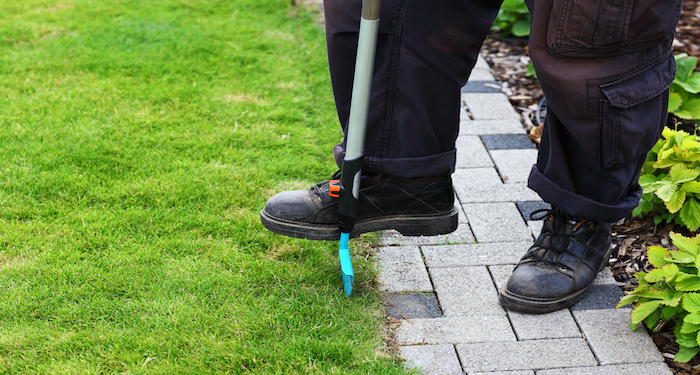
As it is exposed to the elements, constantly water ingress can cause chemical reactions, which can cause an internal expansion in the concrete creating hairline cracks.
Rainwater or water from other sources can get into the concrete through these hairline cracks, and when the temperature drops below zero, the water freezes and expands in these fissures.
This, in turn, causes larger cracks to form until, eventually, the damage is irreparable.
There may be instances when you either want or have to remove concrete edging. It may be that the edging is old and needs replacing, or you may want to put a different kind of edging in its place.
Some older properties may have a relatively old-fashioned border or path edging that needs to be removed or replaced. While some people are happy to do this themselves, others may prefer to hire someone to carry out this work.
The cost of concrete edging removal from your garden or driveway will be between £150-£250 per day or £20-£25 per hour. This cost will include only the labour for removing the old concrete edging without disposal.
Depending on how much concrete edging you need to dispose of, you may need to hire a skip. The cost of hiring a skip will vary according to where you live, how large a skip you use and whether it will be going on the road or on your land.
Typically, a mini skip of 2-3 yards will cost between £100-£120 to hire. However, a larger capacity 6-8 yard skip will cost between £250-£275.
If the skip is on your own land, you won't need a permit, but if it needs to go on the road, then the local authority will need to give permission.
This is normally arranged by the skip hire company, and the cost of the permit is passed on to you, the customer.
If the amount of concrete edging that you need to dispose of doesn’t warrant a skip, then you could take it to your local recycling centre in your car or trailer.
Many recycling centres will not allow vans to deposit rubbish as they consider their commercial vehicle. However, you may be allowed in if you use a small trailer.
FAQs
Q: How do you cut concrete edging?
A: Concrete edging can be cut with an angle grinder which is fitted with a special stone cutting disc. Do not try to use a metal cutting disc on concrete as it will not work.
When cutting concrete edging with an angle grinder, draw a line across the piece that you want to cut. This makes it easier to create a straight and even cut.
Q: Where can you use concrete edging?
A: Concrete edging can be used in many landscaping projects around your property. It can be used to define spaces in your garden, section areas off, surround a garden pond or edge a driveway or path.
Q: Can I install concrete edging as a DIY project?
A: Installing concrete edging as a DIY project is relatively straightforward, although it is a physically demanding job, so it may not be possible for everyone.
The process involves digging a trench for the edging, laying a level line, putting a bed of concrete in the trench and then placing the edging in the trench, ensuring that it is level.
Cuts may need to be made for some pieces. A supporting layer of concrete or ‘haunching’ in front and behind the concrete edging then keeps it in place.
Q: Are straight lines the only option for concrete edging?
A: It is possible for different shaped boundaries to be achieved using concrete edging. Of course, straight lines are the easiest to install, but you can also have curves, arcs and circles.
These will involve more planning and take longer to complete, but the end result will be worth it.
Q: When should concrete edging be replaced?
A: If your concrete edging shows signs of deterioration, then you should consider removing it and replacing it with new edging.
Damaged edging can be dangerous and can cause a trip hazard. It will also look unsightly. It may be possible to just replace the damaged parts of the concrete edging and leave the rest in place.
Sources:
- https://www.buildbase.co.uk/building-materials/drainage-groundworks/kerbs-copings/pavement-kerbs-10484-0000
- https://www.travisperkins.co.uk/edgings-copings-and-caps/travis-perkins-concrete-flat-top-path-edging
- https://www.wickes.co.uk/Products/Gardens/Paving+Walling/Edging,-Coping+Kerbs/c/1000719
- https://www.homebase.co.uk/garden-outdoor/fencing-decking-landscaping/lawn-garden-edging/concrete-edging.list
- https://www.marshalls.co.uk/gardens-and-driveways/kerbs-and-edging/concrete-kerb-and-edging
- https://www.lsd.co.uk/thick-flat-top-edging-pressed-concrete-grey-individual-edgings
- https://www.builderdepot.co.uk/2in-x-6in-concrete-flat-top-path-edging-36in
- https://www.georgelines.co.uk/commercial-paving-kerbs/kerbs/half-battererd-kerbs/
- https://www.frank-key.co.uk/concrete-kerbs-half-batter-250-x-125mm-hb2
- https://corker.co.uk/aggregates/ballast/
- https://www.travisperkins.co.uk/bagged-aggregates/travis-perkins-mot-type-1-sub-base-
- https://brandonhirestation.com/tool-hire/concrete/cement-mixer-hire
- https://ismwaste.co.uk/help/skip-size-guide

